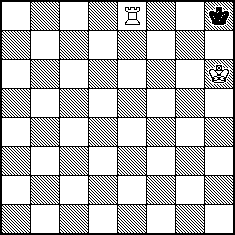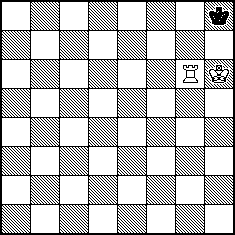The rules of chess
Check, mate, and stalemate
Check
When the king of a player can be taken by a piece of the opponent, one says that the king is in check. For instance, the white player moves his rook to a position such that it attacks the black king, i.e., if black doesn't do anything about it, the rook could take the black king in the next move: we say that the white rook gives check. It is considered good manners to say check when one checks ones opponent.
It is not allowed to make a move, such that ones king is in check after the move. If a player accidently tries to make such a move, he must take the move back and make another move (following the rules that one must move with the piece one has touched, see the chapter on other rules.)

Mate
When a player is in check, and he cannot make a move such that after the move, the king is not in check, then he is mated. The player that is mated lost the game, and the player that mated him won the game.
Note that there are three different possible ways to remove a check:
- Move the king away to a square where he is not in check.
- Take the piece that gives the check.
- (In case of a check, given by a rook, bishop or queen: ) move a piece between the checking piece and the king.

Stalemate
When a player cannot make any legal move, but he is not in check, then the player is said to be stalemated. In a case of a stalemate, the game is a draw.

When black must move, the game is a stalemate
Next: Drawing and resigning
Written by Hans Bodlaender.
WWW page created: September 23, 1997.